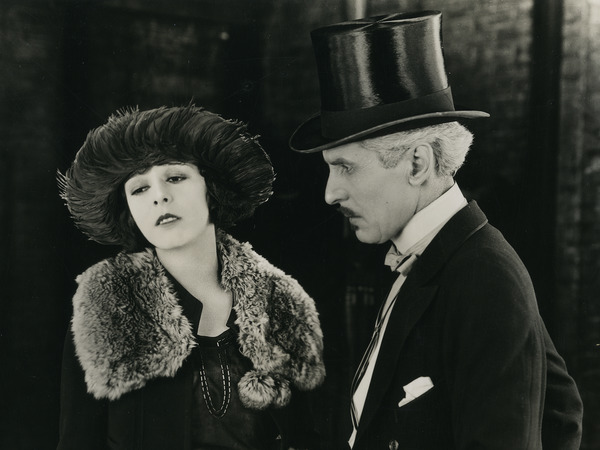SOWING THE WIND
John M. Stahl (US 1921)
Sowing the Wind, released in April 1921, was the second of fourteen films that Stahl would make with producer Louis B. Mayer. Most of the films were shot at Mayer’s Mission Road studio in Los Angeles, until the producer and director moved to M-G-M in Culver City in 1924. Prior to establishing the working relationship with Mayer, Stahl had worked for a number of small production companies. Mayer seems to have provided him with his first stable base of operations. The film was an ambitious production for the Mission Road studio, made with Mayer’s biggest star at the time, Anita Stewart. It was based on a play by Sydney Grundy that dates from the 1890s, which was first adapted for the screen in Britain in 1916, directed by Cecil Hepworth.
Although the film was not covered by the New York Times or the Los Angeles Times, it was extensively reviewed in the popular press. Variety appreciatively characterized it as a “sex drama” that was handled “with delicacy and good taste and gorgeously mounted.” Several aspects of the film associate it with old-fashioned melodrama and what would have been considered naïve taste by the industry trade press. The plot is both highly convoluted and highly stereotyped. It includes two recognition scenes, both of which are implausibly delayed. The first occurs in the death scene in the opium den at the end of the second act, when the heroine, Rosamond, finally realizes that the woman who has been supporting her at a distance for years is her mother. The second occurs at the denouement, when Brabazon, who has been blocking the marriage between Rosamond and his adopted son, realizes that his estranged wife Helen Grey was Rosamond’s mother and she is in fact his daughter. The film also includes a scene, familiar from no less a warhorse than La Dame aux Camélias, of the father asking the heroine to give up his son (in this case his adopted son) for his own good.
The film virtually abandons any attempt at plausible character motivation and psychology in order to orchestrate big dramatic climaxes. For example, the treatment of the first recognition scene is sensationalistic and played for maximum effect. Attempting to ensnare Rosamond into a job as a hostess in his notorious nightclub, the villain Petworth decides to reveal the identity of her mother, who has been living under the alias of Baby Brabant. He takes the girl to an opium den, where they discover Brabant sitting on a bed and holding a pillow as if it were a baby. Aged and infirm, she appears to be doped up and speaks to the pillow: “If only once I could have heard you call me – ‘mother.’” Moved, Rosamond asks Petworth what is going on, and he replies: “You thought yourself too good for my house! Now look and see – just who and what you are! That woman is – your mother!” Trying to protect her daughter, Brabant wildly denies being Rosamond’s mother, accuses Petworth of lying, and physically threatens him. The stress is too much for her, and she falls, dead. Rosamond kneels in long shot behind Baby’s corpse, caressing her mother’s hair, until she realizes with horror that the old woman is dead.
Many elements contribute to the heightening of this scene, which, while certainly farfetched and perhaps somewhat risible in description, I actually find quite compelling. First, the dimly lit and seedy opium den is a fantastically incongruous place for Rosamond to discover her mother. Second, Myrtle Stedman’s performance as Baby Brabant is quite carefully calibrated: beginning in a slow-moving, drug-induced daze, she shifts into a different register, moving more quickly and gesturing more and more vividly as she tries to deny Petworth and take revenge on him. This is abruptly cut short by her death and Rosamond’s gruesome realization.
Sowing the Wind is the work of a director still coming into his own, and there are points where the pacing falters and the plotting becomes obscure. Nonetheless, the film is a wonderful example of the melodramatic tradition, with its explicit didacticism, stark symbolic contrasts, and sensationally overstated use of performance, décor, and staging to drive home the emotional resonance of narrative conflict.
Lea Jacobs

regia/dir: John M. Stahl.
scen: Franklin Hall, dalla pièce di/based on the play by Sydney Grundy (1893, London; 1894, New York).
did/titles: Frank F. Greene.
photog: René Guissart.
asst dir: H.B. Lull.
cast: Anita Stewart (Rosamond Athelstane), James Morrison (Ned Annesley), Myrtle Stedman (Baby Brabant), Ralph Lewis (Brabazon), William V. Mong (Watkins), Josef Swickard (Petworth), Ben Deely (Cursitor), Harry Northrup, Margaret Landis, William Clifford, [Harry La Verne, Iva Forrester].
prod: Louis B. Mayer, Anita Stewart Productions.
dist: Associated First National Pictures.
uscita/rel: 25.04.1921.
copia/copy: 35mm, 7244 ft. (orig. 8867 ft.), 107′ (18 fps); did./titles: ENG.
fonte/source: George Eastman Museum, Rochester, NY.


 Italiano
Italiano